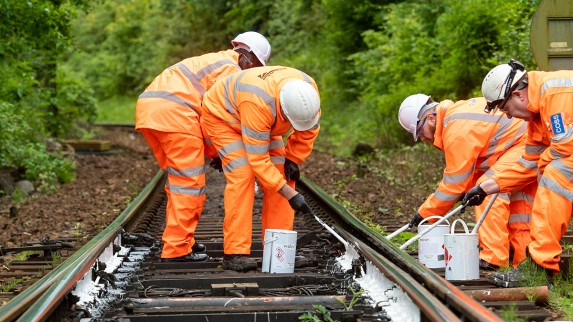Summer 2022 – where are we now?
One hundred and twenty-five. 125 is the daily number of available drivers we have this week across our route depots at Worcester, Snow Hill and Leamington Spa. In the same week last year, again during peak annual leave season, that number was just 101. In this edition we will look at what this near 25% increase in average driver availability means for our route recovery plan and how we aim to be able to move forward more positively.
We will also look at how the route played its part in moving thousands of spectators around the region during the Commonwealth Games and overcame the challenges relating to theft of signalling cable near Tyseley depot halfway through the fortnight of sport.
We know that rebuilding our teams back towards pre-pandemic numbers won’t solve every issue or avoid every potential cancellation. We also know that there have been lots of questions as to why we haven’t been able to operate trains on the route during recent bouts of industrial action, where other routes have remained open. Again, we’ll look into why this has been the case in this update.
Moving from recovery to resilience.
A key theme of this blog over the last year has been to explore the challenges of rebuilding our traincrew teams following years of disrupted training during the pandemic. Thanks to the co-ordinated efforts of our academy trainers, practical instructors, driver managers, rostering and control teams, and not forgetting the new drivers themselves and many other support functions, we have seen an unprecedented near 25% increase in crew availability in just under 12 months.
This progress means we have enough drivers available to operate our current 4 trains per hour timetable. Pre pandemic, we operated a 6 train per hour base timetable which required even more drivers. As we shared in previous updates , we remain on track to recover this establishment by the end of the year. Moving forward, this additional headroom means our Worcester-based drivers can start training on our brand-new class 196 trains without significant impact on day-to-day delivery of the timetable.
Balancing the complex and often competing demands of our driver training programme, testing and entry into service of our new trains, as well as the planned transfer of our legacy fleets to other operators means we often have to make imperfect decisions. The honest truth is there has been no easy solution to the problem, and we know this has damaged faith with some of our customers on the Snow Hill lines. As we move from pandemic recovery towards a more resilient position and begin introducing our new trains to regional services, we will see additional carriages on the Snow Hill lines, in turn hopefully restoring some of this lost faith.
Feeling hot, hot, hot and going for gold.
It’s no secret that this summer has been a scorcher. Record temperatures of 40°C were recorded across much of the Midlands and right across England during the peak periods. The railway network is largely made up of lots of big pieces of metal infrastructure. From the tracks, to signalling cables, overhead wires on some routes, to bridges and the trains themselves.
In basic terms, metal expands when it gets hot and contracts when it gets cold. This will often be invisible to the naked eye, but across something as big as a mile long length of railway track, a few centimetres difference can push things out of line.
In order to keep the railway safe, changes are monitored and managed by specialist engineers who stress test the various structures to cope with and maintain their integrity within known average temperature ranges, as well as building expansion joints and overlay sections into the designs to further deal with any variances. In regions of the world where the average temperature changes more than circa 30°C within an annual cycle, teams will adjust the tension in railway tracks and other large metal structures to account for forecast climatic conditions. In the UK, our historic seasonal changes in temperature have been within the 30°C tolerance range and therefore we have not required this. This is why during the extreme heatwave, with the mercury having risen well above the tolerances, we had to take the bold decisions in advance to slow trains down, suspend certain services altogether and advise customers not to travel unless it was absolutely necessary. By slowing trains down, they can more quickly be brought to a stop if the track ahead is damaged.
The north Warwickshire line in the Whitlocks End area suffered particularly due to the freak intensity of direct sunlight on certain key sets of points. This meant that Network Rail had to introduce a 20mph emergency speed limit at very short notice on some of the hottest days, which meant that many trains were effectively caught up in major traffic jams. While we had a day’s notice of a 50mph temporary speed limit and amended our operation to fit, the further decision to drop it on an emergency basis did cause disruption and led to some customers being left without a service. When “critical rail temperatures” or CRTs are reached - measured by thermometers attached under the track - safety must come first and train movements are often stopped.
We are aware that some social media commentary suggested we took the decision to suspend services on this line, in order to prioritise others – some asked “what was the significant difference in temperature between Henley-in-Arden, and Hampton-in-Arden?” In reality, due to different fleets used on each route, there would be no crossover benefit and as we have laid out above, the decisions were made due to the intensity of the sunlight on key sets of points which were simply more exposed to the sun.

We have also seen similar social media threads suggesting that during recent bouts of industrial action, services are prioritised on other routes, at the expense of the Snow Hill lines. On this point, firstly we are obviously regretful about any disruption caused by industrial action and are working with all industry parties to find as swift a resolution as possible to the national dispute. However, the complexities of operating services in the meantime on or around strike days are significant.
Recent disputes have involved frontline operator colleagues as well as signallers and behind the scenes maintenance teams. This means that decisions over which services are able to run on affected days depend not only on the availability of our own contingent qualified staff but also that of Network Rail’s qualified contingency teams. The short answer is that there are simply not enough contingency workers available to cover the whole network, meaning compromises must be made.
During recent strike action, Network Rail has operated a “key route strategy” which considers not only the passenger services but also the movement of essential and perishable freight. Their key route strategy aims to identify which sections of the railway can be kept open, with the limited amount of suitably qualified people, while moving the largest amount of freight and passengers at the same time. Due to the geography of the Snow Hill lines, there simply isn’t the throughput of long distance, or perishable freight moved on the route, and as such available resources in the region are focused on the West Coast Mainline. If at any point, the ratios of available staff significantly change under any circumstance, we would work with Network Rail to identify if a service could be instated, as we do have contingency personnel who are trained to work on the route.
Looking at some of the other challenges we’ve faced this summer, while Perry Barr on our neighbouring Walsall route played host to the Alexander Stadium and athletics during the Commonwealth Games, the Snow Hill lines saw their fair share of spectator traffic too. The Hawthorns and Smethwick Galton Bridge were designated event stations for visitors to the Aquatics Centre, with Snow Hill and Moor Street stations also serving as key city centre hubs. Over the course of the 10-day festival of sport, we helped carry an estimated extra two million passengers on the region’s railways.
However, in the early hours of Friday 5th August, large amounts of signalling cables were sabotaged and stolen in the Tyseley area, leading to significant disruption on our route. This affected WMR local services, as well as Chiltern Railways and CrossCountry’s long-distance services The scale of the damage did mean that services were affected for more of Friday than we’d have liked, particularly at a time when Birmingham was in the international spotlight. Thanks to the efforts of the Network Rail response teams, the route was reopened by the late morning, with rail replacement buses deployed to get passengers on the move until then. We are working closely with Network Rail and the British Transport Police to appeal for information which may help identify suspects who were caught on CCTV in the area. Follow the link for more information & CCTV appeal.
To the future, and beyond.
With the number of available traincrew now recovering well, we are beginning to look at the future of the Snow Hill route recovery plan and how we move forward to embed some of the other initiatives we’ve been working on into our business-as-usual activity. At some point in the coming months, we will be closing down the formal plan and signing off from this blog for the final time.
This does not mean we will be any less focused on delivering a reliable service for our passengers after a challenging couple of years through the worst of the pandemic and recovery. We are still actively working to deliver projects that will help make the route operation more resilient to any future challenges. For instance, in the coming period, we are hoping to install new walkways around Leamington Spa sidings to allow us to deploy longer joined up sets of trains from Tyseley depot in a morning. Crucially this will mean more flexibility in what type of units we can send down to Leamington, meaning that if we have a shortage of any particular class of train, due to delays in supply of certain specialist parts for instance, we can deploy spare trains from other sets to cover the shortfall.
Our strategic timetabling team are also working hard on the major recast of the Snow Hill timetable, based on gaining a number of class 172 trains back onto the route, as they are released from the Hereford – New St services by our brand-new class 196 trains. With more of the class 172s able to be dedicated to the Snow Hill lines again, we are designing a timetable where every train would a standard 5 carriage length. This is in the pipeline for introduction in spring next year as part of the industry May 2023 timetable changes, subject to the smooth introduction of our new fleets and verification alongside other operators’ changes.
Thanks again to those of you who take time to read this blog. We are glad to be getting back on track, but conscious that we will have to continue to regain your trust. We remain absolutely committed to the Snow Hill lines and making them a success for the region post-pandemic - thank you once again for your patience.
Useful information
If you’d like to speak to a member of the management team in person, we run a series of Whistle Stop Tour events throughout the year that allows you to ‘meet the manager’.
We run an online passenger panel, called Customer Panel , to give you the chance to feed back your experiences and shape the future of your local rail service.
To claim Delay Repay compensation for any journey where you are delayed by 15 minutes or more, please apply online or pick up a Freepost Delay Repay form at your station.


